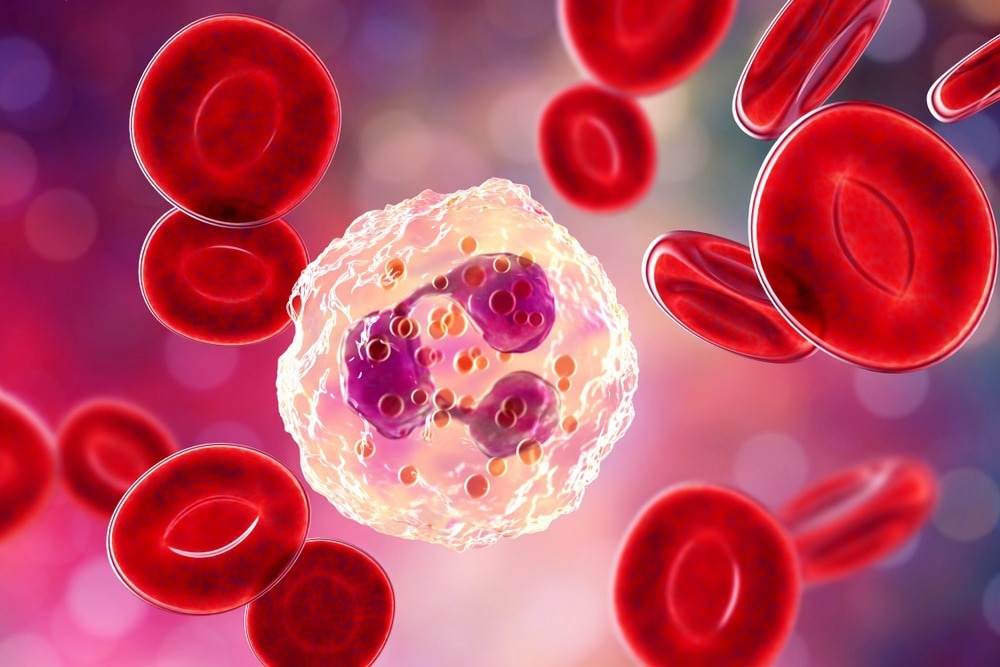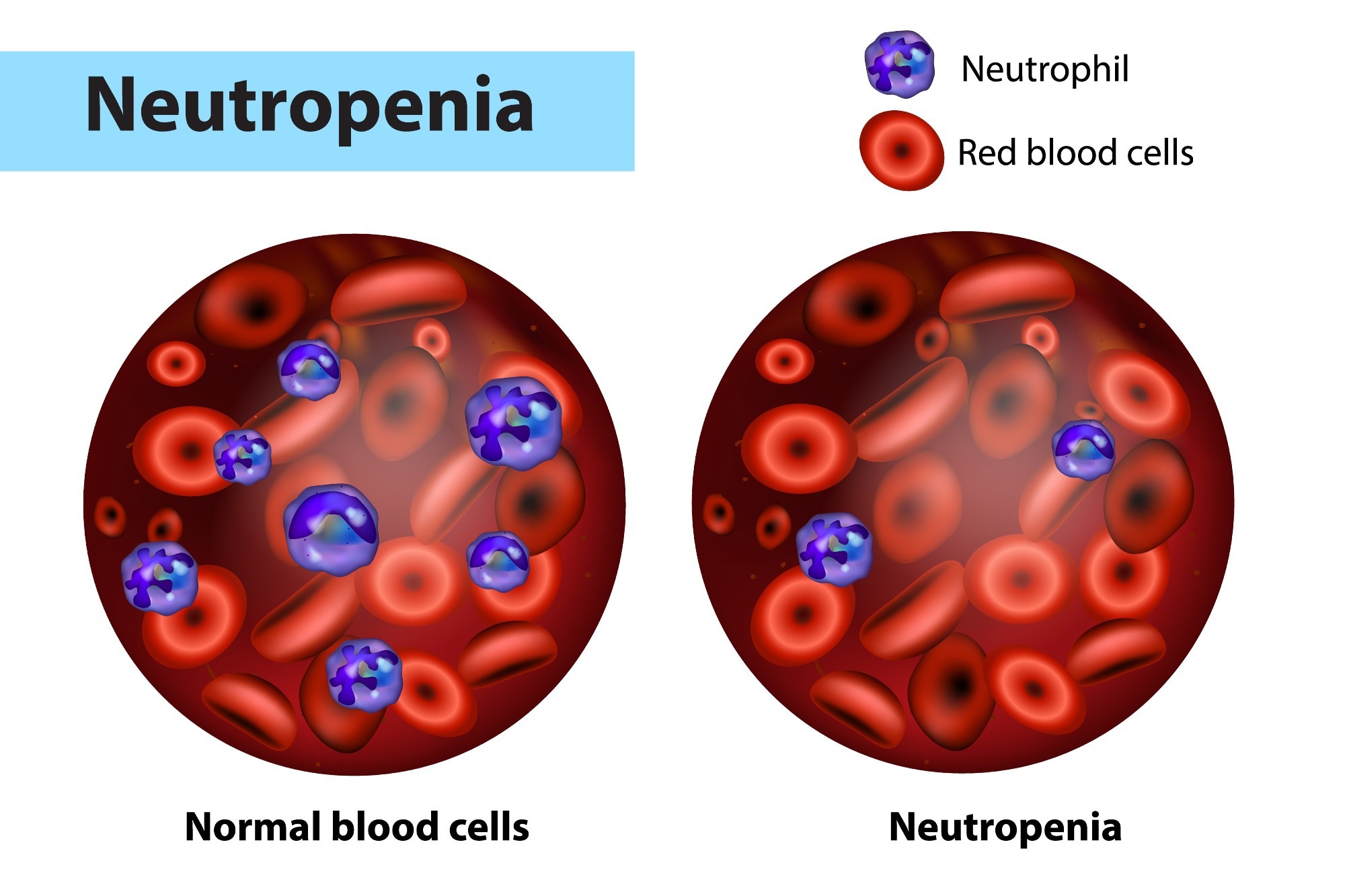Introduction
How to Calculate ANC
What causes Neutropenia?
Significance of ANC in Cancer Treatment
References
White blood cells (WBCs) in our bodies help fight infections. There are various types of WBCs; each has its own way of fighting microbial infections. The most important WBC is called the neutrophil.
The number of neutrophils in the blood is expressed as absolute neutrophil count (ANC), which measures the percentage of neutrophils in the differential WBC count. The ANC of a healthy individual falls in the range of 2,500 to 6,000 per microliter.
A total blood count gives the levels of the three types of blood cells - white blood cells, red blood cells, and platelets. Neutrophils are present in two forms – polys and bands. Polys are also known as segmented neutrophils and are the most abundant WBCs. Bands are also called stabs and are immature polys. Both polys and bands destroy invaders (i.e., microbes) in the body.

Image Credit: Kateryna Kon/Shutterstock.com
How to Calculate ANC
The ANC is calculated by multiplying the number of WBCs in blood by the percentage of total neutrophils. For example, for a WBC count of 7000 per microliter, if neutrophils constitute 40% of the WBCs, the ANC, in this case, will be 7000 × 0.40 = 2800 per microliter.
An ANC below 1,000 per microliter is called neutropenia. ANCs less than 500 per microliter significantly increase the risk of infection. In cancer patients, frequent blood tests are performed to assess WBC count and ANC to monitor the body's response to cancer treatment.
What causes Neutropenia (Low Neutrophil Count)?
Chemotherapy, aimed at treating cancer, is one of the most common causes of neutropenia or an abnormally low neutrophil count. Chemotherapy-driven neutropenia can make patients prone to infections and hence needs to be monitored and managed effectively.
Neutrophils are produced in the bone marrow, a spongy tissue inside our body's large bones. Any factor that hinders the production of neutrophils can cause neutropenia. In addition to leukemia and/ or chemotherapy, factors such as congenital disorders, myelodysplastic syndromes, chronic idiopathic neutropenia, and vitamin deficiencies can cause neutropenia. Infections such as HIV, Malaria, Hepatitis A, B, and C, Lyme disease, and Salmonella infection can also cause neutropenia. Some autoimmune disorders like rheumatoid arthritis and some antibiotics destroy neutrophils and thus may lead to neutropenia.
Neutropenia is usually diagnosed as part of a blood test ordered by the doctor for an existing condition. Once neutropenia is discovered, other tests might be ordered which might reveal the cause of illness. Doctors usually advise some precautions, such as washing hands frequently and wearing a face mask in patients with neutropenia, because they are vulnerable to microbial infections.

Image Credit: Sakurra/Shutterstock.com
Significance of ANC in Cancer Treatment
Neutrophils constitute nearly 55 to 70% of the total WBC count. Acute infections or trauma are the main triggers for the production of neutrophils leading to elevated WBC count, also known as neutrophilia or neutrophil leukocytosis.
In cancer patients, ANC is a reflection of the patient's immunologic status in response to chemotherapy. This therapy suppresses the production of WBC and hence neutrophils, thus increasing infection risks. Hence, a low ANC or neutropenia can indicate the need to reduce chemotherapy dosage or delay subsequent chemotherapy sessions. ANC also allows the prediction of neutropenia-related events, including fever, after chemotherapy sessions. It thus offers a clear picture of the patient's immunologic status.
ANC helps determine the need for antibiotics or other measures along with therapy to decrease complications related to neutropenia. While for an in-patient, a low ANC may indicate the need to isolate the patient to protect them from exposure to infectious agents, in the case of an out-patient, it can highlight the need to keep away from crowds or people having flu or colds. Thus, ANC is a powerful monitoring tool in cancer patients prone to bone marrow suppression due to radiation, chemotherapy, or bone marrow transplant.
References:
- Understanding Your Lab Test Results (2022). Available at: https://www.cancer.org/treatment/understanding-your-diagnosis/tests/understanding-your-lab-test-results.html (Accessed: 16 August 2022).
- (2022) Myamericannurse.com. Available at: https://www.myamericannurse.com/what-does-the-absolute-neutrophil-count-tell-you/ (Accessed: 16 August 2022).
- Neutropenia (low neutrophil count) When to see a doctor (2022). Available at: https://www.mayoclinic.org/symptoms/neutropenia/basics/when-to-see-doctor/sym-20050854 (Accessed: 16 August 2022).
Further Reading